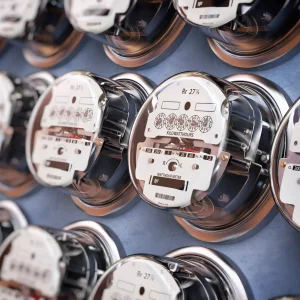Updated December 15th, 2022, NEM 3.0 Update – The CPUC voted to approve NEM 3.0. The voted result means the start of the 120-day sunset period for NEM 2.0. Customers will have until April 14th, 2023, to get their application for PTO submitted. (Check out the latest NEM Updates)
What is CA Net Energy Metering?
 California net energy metering (also known as net metering or NEM) is California's foundation for solar incentives. It was created as a way of using the utility grid to store energy generated by solar panel systems for use at a later time.
California net energy metering (also known as net metering or NEM) is California's foundation for solar incentives. It was created as a way of using the utility grid to store energy generated by solar panel systems for use at a later time.
Homeowners with solar power can measure the energy they generate with an energy meter and compare it to the energy they consume. The sum, or net, of what is left decides how much they have to pay on the next bill to their utility company.
You generate credits toward your bill if you produce more electricity than you consume. Some utilities apply this to your account, while others issue payments. Most utility companies now place you on a 12-month billing cycle and “settle up” the bill at the end of each year.
When your solar panels generate more electricity than you use, the extra energy is sent back to the grid, running your electric meter backward. With a properly designed solar energy system, you will produce enough energy for your home all year long. However, you will produce more electricity in the summer and less in the winter.
The regulation details for repayment are set by California State Assembly Bill 920, allowing utilities to make payments to NEM customers who generate more electricity than they use over the entire year. This payment, known as your Net Surplus Compensation (NSC), is calculated by the utility company over your 12-month billing cycle.
They use a 12-month average of market rates for energy, which is usually about 2¢ to 4¢ per kilowatt-hour (kWh). They use this average rate for what you have consumed and subtract your solar credits or the energy you produced that year multiplied by its monetary value.
Essentially, you are using the utility grid as a battery to support your solar panel system and deliver energy when you are not generating, such as at night. Your solar panels are now the actual energy provider for your home.
California NEM in 2022
The California solar net energy metering (NEM) program, or regulations created by legislation, few changes throughout the years. We are currently in the second version of NEM 2.0. This current regulation standard has been favorable to solar energy owners and producers. The passage of California AB 327 in 2013 set NEM 2.0’s guidelines, which went into effect at the end of 2016.
The legislation safeguarded homeowners' solar investments, keeping utilities from deviously changing rates and fees to hinder or steal credits from homeowners generating solar energy. The state was the one making the rules and determinations now, not utility companies.
Recently, the California Public Utility Commission formally opened its NEM 3.0, which they lobbied for heavily, which will change the rules for NEM tariffs for California solar energy system owners. They claim that “it’s not fair for non-solar customers to subsidize solar for the minority that does have solar.”
When in actuality, they are unhappy that residents who generate solar power pay very little compared to those who don’t have solar panels. Over the years, the net energy metering program has enabled solar homeowners to generate more clean energy than they need, making their electric bills cheaper and cheaper.
The for-profit utility companies did not like the loss in revenue. Now you see the problem, especially when utilities can add fees and increase rates pretty much on a whim.
Why wouldn’t every Californian resident switch to solar with incentives like NEM? This is what keeps utility CEOs and shareholders up at night, especially with rates on the continual rise.
Read More NEM Updates:
NEM 3.0 – How California Solar Is Changing In 2022
Net Zero & The Importance of Solar Panel System Size
Top 10 Solar Panel Benefits – Reasons to Go Solar
When Will NEM Change?
The latest estimate is that the final decision will be made in January 2022. Implementing these changes is expected to happen within 6 months of that final decision. NEM 3.0 is also likely to impact solar projects' economics across California significantly.
While the final rules for this version of NEM are yet to be determined, the inevitable outcome is that the value of solar will probably go down. While we are fighting to stop these changes, we don’t have the political power and resources of the vast electricity corporations.
How to avoid NEM changes in 2022?
If you don't have it already, the simple answer is to install a solar energy system now and get into the NEM program before the change.
Anyone that starts installing their solar power system under the current system, NEM 2.0, is locked into its rules and regulations for 20 years. That means if you go solar now, the new and worse NEM 3.0 will not affect you. Your system and account will be “grandfathered in” to NEM 2.0.
This is the best protection for solar investments in all of California. While this new NEM system hinders solar development, you will enjoy your energy independence and little to no energy bills for at least two decades, guaranteed.
We still don’t know how long NEM 2.0 program standards will last. Protect your budget and energy future by installing solar on your business or property. Like Option One Solar, Dependable solar experts Option One Solar, are here to help you go solar and get NEM 2.0 today.





